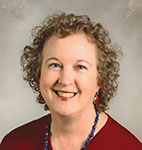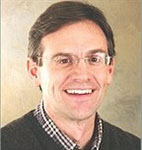Planners consider ecological, social and financial implications
At Ascension and its facilities, leaders making operational decisions weigh the financial, environmental and social impact of their decisions — three interrelated areas of concern, especially in a ministry premised on social justice. The executives also gauge how their choices could have an effect on individual and population health and health care costs. That's according to presenters of a CHA webinar.

This detention basin at the new Borgess Health Park of Battle Creek, Mich., has a layer of crushed limestone that improves filtration to the groundwater aquifer. The health park is higher than an adjacent natural wetland and the basin protects the wetland from the facility’s storm water runoff.
During the presentation, Ascension environmental stewardship experts explained how these "Triple Bottom Line" and "Triple Aim" considerations factor into strategic planning throughout the 131-hospital system. The presenters of the Aug. 19 webinar, "Environmental Stewardship: Connecting Catholic Social Teaching, Triple Bottom Line and Triple Aim," were Lois Sechrist and Eric Buzzell. Sechrist is senior analyst with the Facilities Resource Group of St. Louis-based Ascension; and Buzzell is vice president of general services and property management for the system's Borgess Medical Center of Kalamazoo, Mich.
Sechrist explained to Catholic Health World that Ascension is moving toward connecting the Triple Bottom Line, which takes into account the social, environmental and financial costs and benefits of decisions, and the Triple Aim, which considers how decisions made by health care leaders can enhance patients' experiences, improve population health and reduce the per-capita cost of health care. Sustainability expert John Elkington introduced the Triple Bottom Line approach in 1994; and Don Berwick, Tom Nolan and John Whittington at the Institute for Healthcare Improvement introduced the Triple Aim framework in 2008.
An Ascension "Environmental Stewardship Program FY13 Report" that Sechrist and Buzzell referenced during the webinar says that, "Bringing the Triple Aim and the Triple Bottom Line together in a (health care) sustainability program is a powerful alignment that draws on the goals of the two concepts."

Sechrist

Buzzell
During the webinar, Sechrist used Ascension's policy to avoid the use of bottled water to demonstrate how the concepts align. Ascension's contracts with meeting venues require the venue to provide pitchers of tap water, not bottled water. Sechrist said the policy has a positive environmental impact in that it saves the materials and energy used to produce and transport bottled water and it keeps the plastic out of the waste stream. The financial impact of the policy is measured in reduced meeting costs for Ascension, since pitchers of water cost nothing, but bottled water carries a cost. Sechrist said those savings can reduce expenses, freeing up funds for use in serving the poor and vulnerable, which has a beneficial social impact. Care of the poor and vulnerable also accomplishes a patient care goal of the Triple Aim. Sechrist explained to Catholic Health World that factoring out the pollution related to shipping bottled water supports the health of populations, another Triple Aim goal.
During the webinar, Buzzell described the application of the triple concepts in the construction and operations of Borgess Health Park of Battle Creek, Mich., a $26 million ambulatory care facility that opened in July. The facility has only light-emitting diode lighting, which uses extremely low amounts of energy, according to Buzzell. "Day-lighting" technology senses the amount of sunlight and adjusts artificial lighting accordingly. And, parking lot light technology senses approaching vehicles and adjusts emitted light as needed. The facility also has electric vehicle charging stations and bike racks, to encourage green transportation choices.
Buzzell explained that many of these energy-saving features hit all three aspects of the Triple Bottom Line, with green features shaving environmental and financial costs, and with financial savings freeing up funds for people in need. The facility's features also address Triple Aim goals. Cost savings from sustainable design reduce operating costs, which can be applied to lower per-capita costs for care. Also, Borgess Health erected the facility in a location that is accessible to underserved populations, addressing the patient care aspect of Triple Aim. And, with features that reduce carbon emissions and that cut waste, the ambulatory care site can avoid negatively impacting population health.
Sechrist told Catholic Health World that tying together the triple concepts "is a work in progress for Ascension. … This is a beneficial idea and natural fit that will take work over time to fully integrate into our daily activities."
She added that Ascension wants to increasingly get environmental staff who are focused on Triple Bottom Line questions in the same room with operations staff focused on Triple Aim goals.
During the webinar, Sechrist and Buzzell said the focus on the triple concepts for major decisions furthers Ascension's mission to serve all people, especially those who are poor and vulnerable, and to improve the health of individuals and communities.
"It's a deep and long-lasting commitment," said Buzzell.
| Laundry facility meets economic, social and environmental goals
During the Aug. 19 CHA-hosted environmental webinar, the Ascension Health speakers shared multiple examples of how planners can help ensure their projects address many different Triple Bottom Line goals at once. The speakers were Lois Sechrist, senior analyst with the facilities resource group of St. Louis-based Ascension Health; and Eric Buzzell, vice president of general services and property management for Ascension Health's Borgess Medical Center of Kalamazoo, Mich. Buzzell described during the webinar the application of the Triple Bottom Line in the design and operations of a laundry facility. Borgess Medical Center once operated a laundry facility in a remote area of Kalamazoo that was inconveniently located for low-income employees without reliable transportation. When the hospital was ready to upgrade to a more ecologically sound laundering process than it was using, it found for the new facility's location a brown field site central to the areas where many of its employees live. A brown field is a tract previously used for industrial or commercial purposes. By developing a brown field, Borgess did not damage pristine land, and therefore accomplished an environmental aim. By locating near employees, the facility addressed their transportation concerns -- many could bike or walk to work -- and made it easier for them to get to and from work, hitting a social aim. Additionally, Borgess built the facility to use much less water and to reclaim heat during the laundering process. The facility also allows Borgess to launder and reuse some materials -- under special sterilization standards -- that the medical center would have thrown out in the past. These improvements are producing both financial and environmental benefits, said Buzzell. Buzzell also described how some projects can address some aspects of the Triple Bottom Line in unexpected ways, including a project to make good use of food waste from patient trays and the cafeteria at Ascension Health's Our Lady of Lourdes Memorial Hospital in Binghamton, N.Y. The best food scraps are given to pig farmers locally, to feed their pigs, and those farmers donate an animal to a local food bank, a social good. Other food scraps from Lourdes are used in landscaping at the hospital and in an on-site garden. Using waste in this way at the hospital instead of sending it to a landfill saves Lourdes money, a financial benefit. |
Copyright © 2014 by the Catholic Health Association
of the United States
For reprint permission, contact Betty Crosby
or call (314) 253-3477.